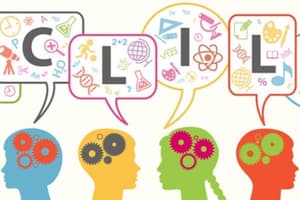Podcast
Questions and Answers
Which of the following methods is NOT considered a past trend in TEFL?
Which of the following methods is NOT considered a past trend in TEFL?
- Grammar-Translation
- Total Physical Response
- Cognitive Learning Theory (correct)
- Direct Method
Methodology in language teaching refers to the theory only, without any practical application.
Methodology in language teaching refers to the theory only, without any practical application.
False (B)
What does the term 'method' imply in language teaching?
What does the term 'method' imply in language teaching?
An application of an approach in the context of language teaching.
In traditional teaching methods, classrooms are primarily ______.
In traditional teaching methods, classrooms are primarily ______.
Match the following language teaching terms with their definitions:
Match the following language teaching terms with their definitions:
Which statement best describes the role of the teacher in traditional language teaching methods?
Which statement best describes the role of the teacher in traditional language teaching methods?
The Communicative Language Teaching method promotes teacher-centered classrooms.
The Communicative Language Teaching method promotes teacher-centered classrooms.
What are the four elements considered when developing a method in TEFL?
What are the four elements considered when developing a method in TEFL?
The organized content and objectives that are sequenced and taught using methods is called a ______.
The organized content and objectives that are sequenced and taught using methods is called a ______.
Which method emphasizes the physical involvement of learners in the learning process?
Which method emphasizes the physical involvement of learners in the learning process?
What is a primary motive of teachers in traditional teaching?
What is a primary motive of teachers in traditional teaching?
In traditional teaching, there is a strong alignment between objectives, activities, and assessments.
In traditional teaching, there is a strong alignment between objectives, activities, and assessments.
Name one designer method that emerged in the 1970s and 1980s.
Name one designer method that emerged in the 1970s and 1980s.
The affective-humanistic approach emphasizes the feelings of students and __________ in the classroom.
The affective-humanistic approach emphasizes the feelings of students and __________ in the classroom.
Match the following characteristics with traditional language classes:
Match the following characteristics with traditional language classes:
What is more important in interactive classroom environments than materials or methods?
What is more important in interactive classroom environments than materials or methods?
Community Language Learning is an example of a traditional teaching method.
Community Language Learning is an example of a traditional teaching method.
What kind of classroom procedures are widely used in affective-humanistic approaches?
What kind of classroom procedures are widely used in affective-humanistic approaches?
In traditional language classes, teaching materials are primarily viewed as __________.
In traditional language classes, teaching materials are primarily viewed as __________.
What relationship is typical between teachers and students in traditional language classes?
What relationship is typical between teachers and students in traditional language classes?
Flashcards
Method
Method
A practical application of an approach in the context of language teaching.
Approach
Approach
The theory or philosophy behind how a language should be taught.
Methodology
Methodology
A systematic study and analysis of the methods and practices used in language teaching, informed by the approach.
Techniques
Techniques
Signup and view all the flashcards
Syllabus
Syllabus
Signup and view all the flashcards
Traditional teaching methods
Traditional teaching methods
Signup and view all the flashcards
Teacher
Teacher
Signup and view all the flashcards
Chalk and talk methods
Chalk and talk methods
Signup and view all the flashcards
Regimented classrooms
Regimented classrooms
Signup and view all the flashcards
Lack of student collaboration
Lack of student collaboration
Signup and view all the flashcards
Traditional Teaching
Traditional Teaching
Signup and view all the flashcards
Communicative Language Teaching (CLT)
Communicative Language Teaching (CLT)
Signup and view all the flashcards
Total Physical Response (TPR)
Total Physical Response (TPR)
Signup and view all the flashcards
Community Language Learning (CLL)
Community Language Learning (CLL)
Signup and view all the flashcards
Suggestopedia
Suggestopedia
Signup and view all the flashcards
The Acquisition Hypothesis (Krashen)
The Acquisition Hypothesis (Krashen)
Signup and view all the flashcards
Universal Grammar (Chomsky)
Universal Grammar (Chomsky)
Signup and view all the flashcards
Affective-Humanistic Approach
Affective-Humanistic Approach
Signup and view all the flashcards
Designer Methods
Designer Methods
Signup and view all the flashcards
Study Notes
TEFL Trends: CLIL and PBL
- Course title: TFL 613: Trending Approaches in TEFL: CLIL and PBL
- Instructor: Ph.D., Kymbat Smakoya
Past TEFL Trends (20th Century)
- Grammar-Translation
- Direct Method
- Audio-lingual Method
- Community Language Learning
- The Silent Way
- Suggestopedia
- Total Physical Response
- Natural Approach
- Communicative Language Teaching
Approach, Method, Methodology, and Techniques
- Approach: The underlying philosophy or theory guiding language teaching. It provides the theoretical foundation and principles about language and language learning.
- Methodology: The study and analysis of different methods and practices informed by the approach. It is a system of practices and procedures that teachers use to teach.
- Method: A practical plan and techniques derived from the methodology and approach. It's a way of implementing the approach (e.g., syllabus, progression, materials).
- Techniques: Specific classroom tasks and activities used to implement the method.
Language Teaching Methodology
- The diagram illustrates a sequence beginning with theories of language and learning, flowing to instructional design features of the method, and finally culminating in observed teaching practices. This methodology is a system of practices and procedures for teaching.
Traditional Teaching Methods
- Teacher-centric: Teachers are the main source of knowledge and take responsibility for dispensing knowledge, not facilitating it.
- Chalk and talk methods are prominent.
- Regimented classrooms are common.
- Less emphasis on collaboration and group learning.
- Lectures are common.
- Primary focus is exam preparation rather than concept understanding.
- Poor alignment between objectives, activities, and assessments.
Other Methods
- Community Language Learning
- The Silent Way
- Suggestopedia
- TPR (Total Physical Response)
Chomskyan Revolution in Linguistics
- Linguistic and language teachers focused on the "deep structure" of language.
- Psychologists considered the affective and interpersonal aspects of learning.
Designer Methods
- The "designer methods," popular in the 1970s and 1980s (labelled as such by Nunan, 1989), included innovative approaches like Total Physical Response (TPR) and Community Language Learning.
- Emphasis on affective factors (feelings and respect for students and teachers)
- Increased student involvement and personal learning experience.
- Interactive procedures (pair and small-group work) are emphasized.
- Class atmosphere is considered more important than just materials or methods.
Traditional Language Class Features
- Traditional teacher beliefs and values.
- Primary language learning views.
- Theories of second/foreign language learning.
- Teacher-student relationships and roles.
- Materials and resources used.
- Classroom activities.
21st-Century TEFL/TESOL Trends
- Popular strategies, approaches, policies, values, principles, and techniques in foreign language learning & teaching.
Contemporary Language Class Features
- Changes in teacher-student relationships, roles, and competencies.
- Management and learning styles.
- Content to be learned and expectations of all stakeholders.
- Learning materials and equipment.
- Assessment of learning and teaching.
Suitable Methods
- Which methods have features that may still be appropriate for contemporary language teaching?
Why the Search for the Best Method Ended
- Reasons behind the decline in the search for the "best" language-teaching method after the 1990s.
Specific References and Examples
- Dead Poets Society (1989)
Problems With Past Methods
- Issues with methods like Grammar-Translation, Direct Method, Audio-lingual Method, Community Language Learning, The Silent Way, Suggestopedia, Total Physical Response, Natural Approach, Communicative Language Teaching.
Studying That Suits You
Use AI to generate personalized quizzes and flashcards to suit your learning preferences.




